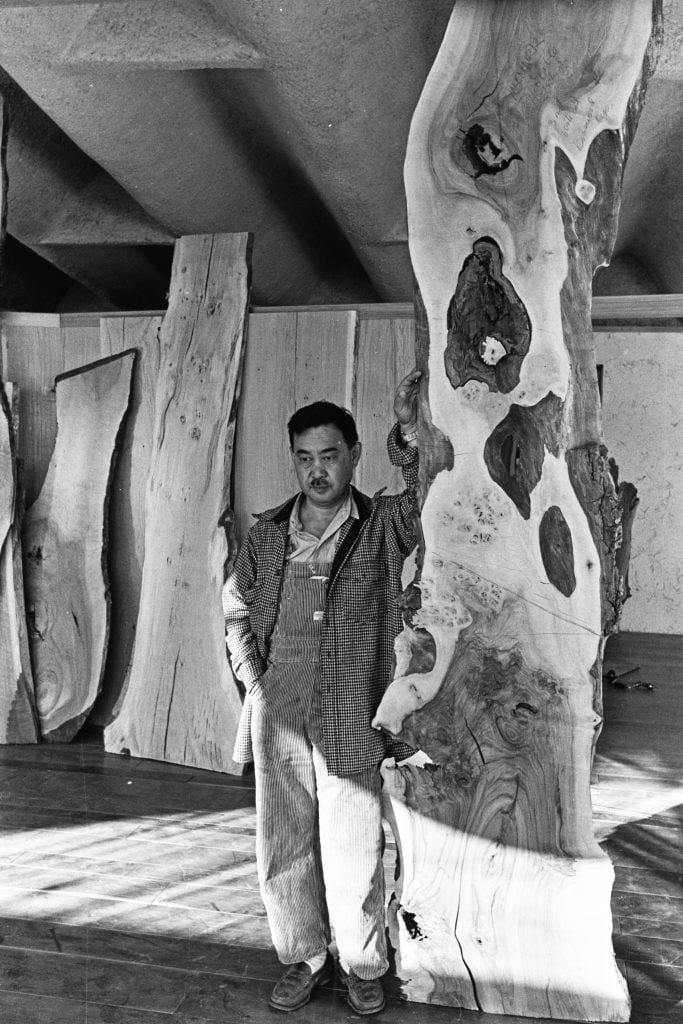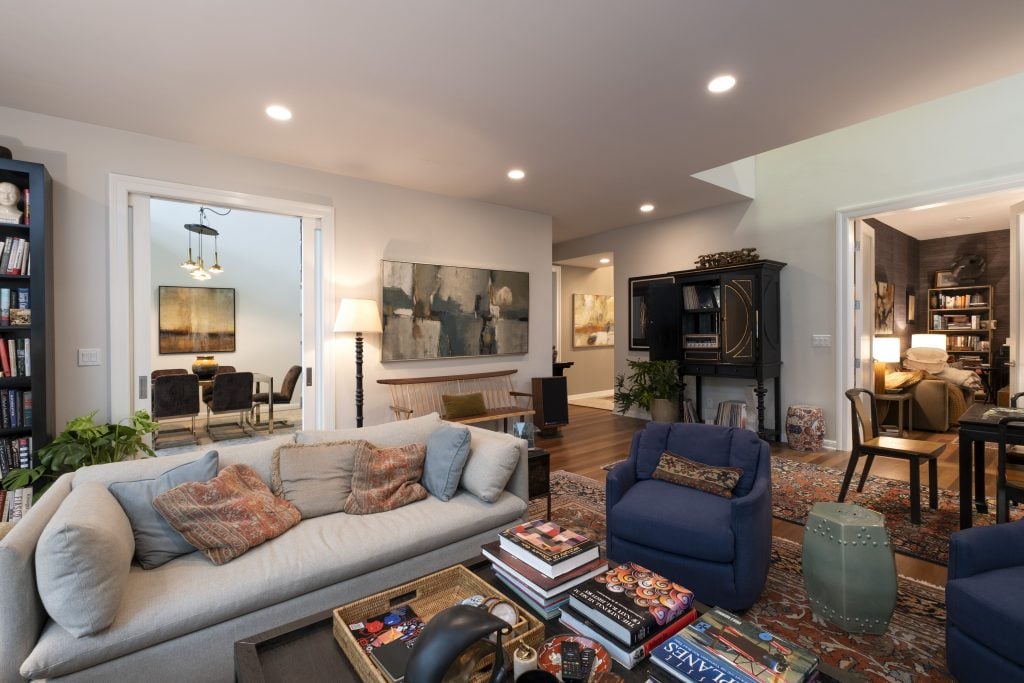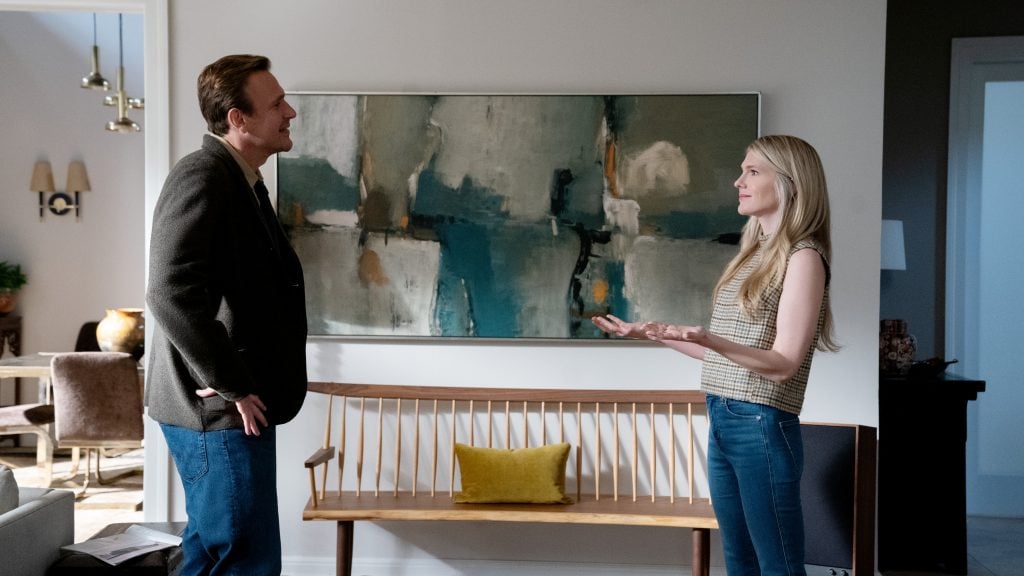Pop Culture
How Harrison Ford’s Passion for Design Shaped the Set of His New Show
The actor, who worked for a carpenter for time, brings his enthusiasm for the American artist and woodworker George Nakashima to the set of 'Shrinking' on Apple TV+.

The actor, who worked for a carpenter for time, brings his enthusiasm for the American artist and woodworker George Nakashima to the set of 'Shrinking' on Apple TV+.

Karen Chernick

“I can’t believe he made up a stupid game just to get away from me,” says Alice (played by Lukita Maxwell) to Paul (Harrison Ford) in season one episode two of Shrinking, the Apple TV+ show about an oddball crew of California therapists. “I mean, what the hell is pickleball?” The two chat and eat burgers on Paul’s couch while behind them, against a wall, a distinctive wooden bench makes its premiere cameo (one of many, and more frequent now as season two streams through December). The bench combines light-colored hickory spindles and a richer walnut crest rail and seat, with a front free edge, all rendered in a handcrafted minimalism that appears both modernist and Shaker-inspired.

The Nakasima look-alike bench is visible in the left background. Shrinking as: Courtesy of Apple TV+.
It looks like a bench made by master American woodworker and architect George Nakashima. And Harrison Ford requested it, specifically.
“Paul would have gone to Design Within Reach, walked around, and picked out some basics,” the award-winning actor told director and producer Randall Winston early in the set design process. “Two of these, three of those, and then mixed it up with some great 18th- and 19th-century antiques and vintage pieces like an iconic George Nakashima bench, a Biedermeier chest, and maybe a Harvey Probber sofa.” Production designer Cabot McMullen and set decorator Andrea Fenton soon went about putting these requests into practice, except it’s no small feat to source an original Nakashima bench.

Portrait of American architect and furniture maker George Nakashima in his workshop, New Hope, Pennsylvania, 1959. Photo by Jack Rosen/Getty Images.
Nakashima’s Walnut Greenrock Bench at the Metropolitan Museum of Art wasn’t available, obviously. Neither was his Conoid Bench at the Smithsonian American Art Museum nor the one that Dave Brubeck commissioned for his home in Connecticut. Iconic Nakashima benches—and his pieces in general—aren’t easy to come by.
Trained as an architect, Japanese American artist Nakashima was a leading figure in the mid-20th century American Studio Craft movement. Drawing on traditional Japanese woodworking traditions as well as American Shaker style, Nakashima designed and crafted pieces highlighting the natural beauty of wooden slabs that he spent significant energy sourcing. Any inherent flaws in the wood were celebrated instead of concealed, all while adhering to a minimalist modernism.

Harrison Ford, who worked as a carpenter, specifically requested the bench on set. Shrinking as: Courtesy of Apple TV+.
“The thing about him that was amazing was that he combined American and Japanese vernacular in a modern way. It was like a triumvirate,” explains Robert Aibel, founder and co-director of Moderne Gallery in Philadelphia, which has sold Nakashima since the mid-1980s and has the largest selection of the workshop’s designs in the United States. “It makes him so unique. And nobody else was working with wood the way he was.”
All this is to say that Ford’s request was discerning, if not impossible. “One Nakashima bench, like that one, would have been our entire budget for the whole set,” says McMullen. While Nakashima prices vary—due to condition, the fact that no two pieces are identical, and whether or not original documentation (such as Nakashima’s preliminary drawings) exists—Aibel estimates the average price for the kind of bench that appears on Shrinking at $20,000. Knowing an original was out of budget, Fenton found a good reproduction of it instead (on Etsy of all places).

Shrinking as: Courtesy of Apple TV+.
“It was important to me that we find the right piece,” adds McMullen (who actually met Nakashima while working on a 1985 feature episode about him for National Geographic Explorer). “And on camera, you really can’t tell the difference. It’s a completely faithful reproduction of one of his originals.”
That very faithful reproduction has appeared quite regularly in season two of Shrinking, as we learn more about Paul’s personal life and see him outside of his therapy office. Ford referred to Paul’s apartment as his ‘fortress of solitude,’ and wanted that set to be able to tell viewers something about Paul’s varied interests, one of which was an interest in midcentury modern design.
While actors sometimes look to production design as a tool for communicating information about their characters, the specific request for a Nakashima bench goes a bit deeper for Ford. Ford was himself, for a time, a working carpenter.
For a few years in the early 1970s, Ford was a self-taught professional carpenter with A-list clients including musician Sérgio Mendes, writers Joan Didion and John Dunne, and film director Richard Fleischer. Rumor has it that Ford was working as a carpenter when he met director George Lucas, who then asked him to audition for the role of Han Solo in Star Wars.
But carpentry was more than just a gig to make ends meet, for Ford. “I learned that craft was something that took long, hard work. The way of thinking about things that I learned from carpentry, I began to understand would serve me in acting as well,” the actor said in 2000 during an episode of Inside the Actor’s Studio. “And that is, to work from the ground up. One thing on top of another thing, on top of another thing.”